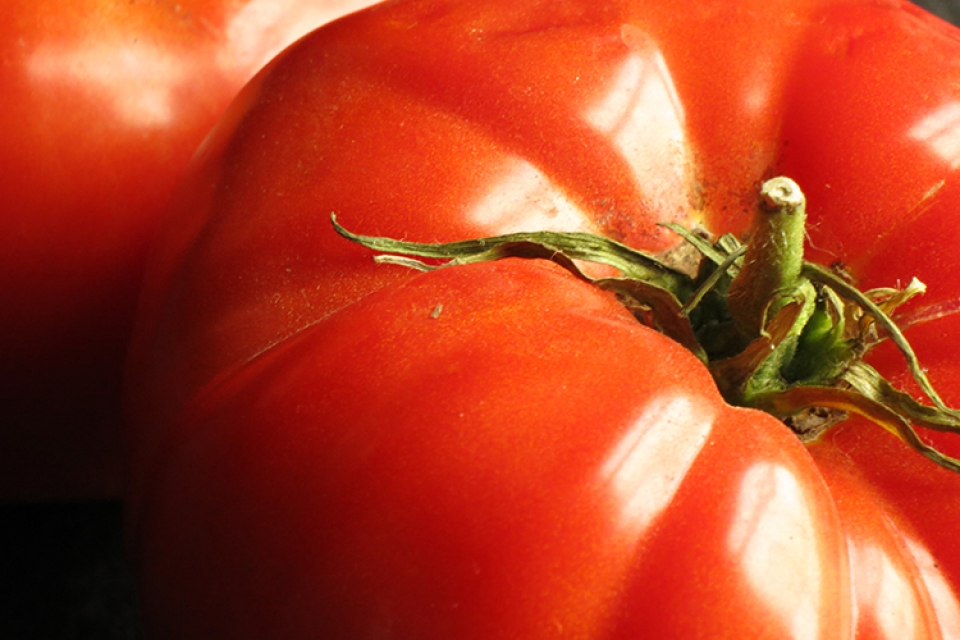Guest Article: Is that Organic Tomato Hydroponically Grown?
By Nicole Dehne, Certification Administrator, Vermont Organic Farmers
Walk into any natural food store regardless of the season and you are likely to find a prominent display of gorgeous, red, organic tomatoes. The stores understand that our desire for tomatoes demands year-round availability. But what they might not understand is how consumers would react if they learned that some of those organic tomatoes may be hydroponically grown. Last week, this topic was being discussed at the Vermont Organic Farmers annual meeting. And the question was posed, should hydroponic crops be allowed to display the certified organic seal?
In order to answer that question, you need to understand the founding principles of the organic farming movement. The original organic farmers and gardeners saw that the use of chemical fertilizer was diminishing soil fertility, which resulted in malnourished plants. The founders of the organic movement recognized that the soil was more than just a structure to hold up plants. Rather, they looked at soil as a critical component of the health of the plant. If they created a “healthy” soil full of microbes, minerals and nutrients, they theorized that the plants grown in this soil would be healthier both in fighting off diseases and pests and by providing more nutrients to the humans and animals that ate them. At the time this idea that the soil was a living ecosystem was revolutionary, as the common practice for growing crops was based on feeding the plant through synthetic fertilizers.
In 2002, the USDA developed national standards defining organic farming and processing. As one would expect, these regulations require that organic farmers maintain or improve the biological, chemical, and physical condition of the soil. Ask any organic farmer today and they will most likely describe themselves as stewards of the soil. The soil is their focus. You’ll never hear an organic farmer call their soil dirt! It’s also the focus of the USDA organic regulations and the fact that there is no soil involved in hydroponic production is the reason many people feel it should not be considered organic.
In contrast to organic production, hydroponic production is a system of growing crops that intentionally removes soil from the picture. Hydroponic crops are grown using 16 or 17 minerals in the correct proportions. The roots of the plants are placed in water and the mineral solution is dissolved into that water. For “organic” hydroponic systems these nutrients would have to be derived from natural sources like liquid fish. Sometimes the plants are grown in moist inert medium such as perlite or coconut husks. Unlike soil, the medium is not providing any nutrients. In a soil-based system, nutrients from the soil dissolve in water and the roots of the plants absorb them. In a hydroponic system, nutrients are dissolved into the plant’s water supply and the soil is thus no longer a requirement for the plant to grow. Almost any plant can be grown this way. But the question remains as to whether that plant should be considered organic.
In 2010, the National Organic Standards Board (NOSB), the advisory board to the National Organic Program (NOP), considered this question. The board made the following strong statement in their recommendation, “Hydroponics, the production of plants in nutrient rich solutions or moist inert material, or aeroponics, a variation in which plant roots are suspended in air and continually misted with nutrient solution, have their place in production agriculture, but certainly cannot be classified as certified organic growing methods due to their exclusion of the soil-plant ecology intrinsic to organic farming systems and USDA/NOP regulations governing them.” So why do we continue to see hydroponically grown certified organic tomatoes available for sale?
The current administration of the National Organic Program continues to allow the certification of hydroponic operations despite the recommendation from the NOSB that clearly states it is not compatible with organic production. This has angered many consumers and organic farmers in Vermont and across the nation. One such organic farmer, David Chapman of Long Wind Farm, has started a petition for consumers and farmers to sign asking the NOP to stop allowing hydroponic crops to be labeled organic. And he has the support of his fellow farmers. On January 29th, producers certified by Vermont Organic Farmers voted to approve the following resolution, “Vermont Organic Farmers demand that the National Organic Program accept the 2010 NOSB recommendation to prohibit soil-less hydroponic vegetable production as certified organic.” Many producers present at the meeting expressed concern that the NOP seemed to be ignoring the advisory board created to represent the diverse interests of the organic community.
The United States is one of the few countries that allows hydroponics to be labeled organic. Mexico, Canada, Japan, New Zealand, and 24 European countries, (including Holland, England, Germany, Italy, France, and Spain) all prohibit hydroponic vegetable production to be sold as organic in their own countries. Which means “organic” hydroponic producers in other countries are often growing exclusively for a US market. Presently, the vast majority of the “hydroponic organic” produce sold in this country is grown in Mexico, Canada, or Holland.
It’s time to take a stand. Consumers who expect organic crops to be grown in the soil should sign on to Mr. Chapman’s petition. It’s high time that the NOP heard loud and clear that they can’t take the soil out of organic. And that’s the real dirt.
Sign on to David Chapman’s petition:
http://www.keepthesoilinorganic.org
Read the NOSB recommendation:
http://www.ams.usda.gov/AMSv1.0/getfile?dDocName=STELPRDC5084677
To learn more about certified organic:
http://nofavt.org/find-organic-food/why-organic
